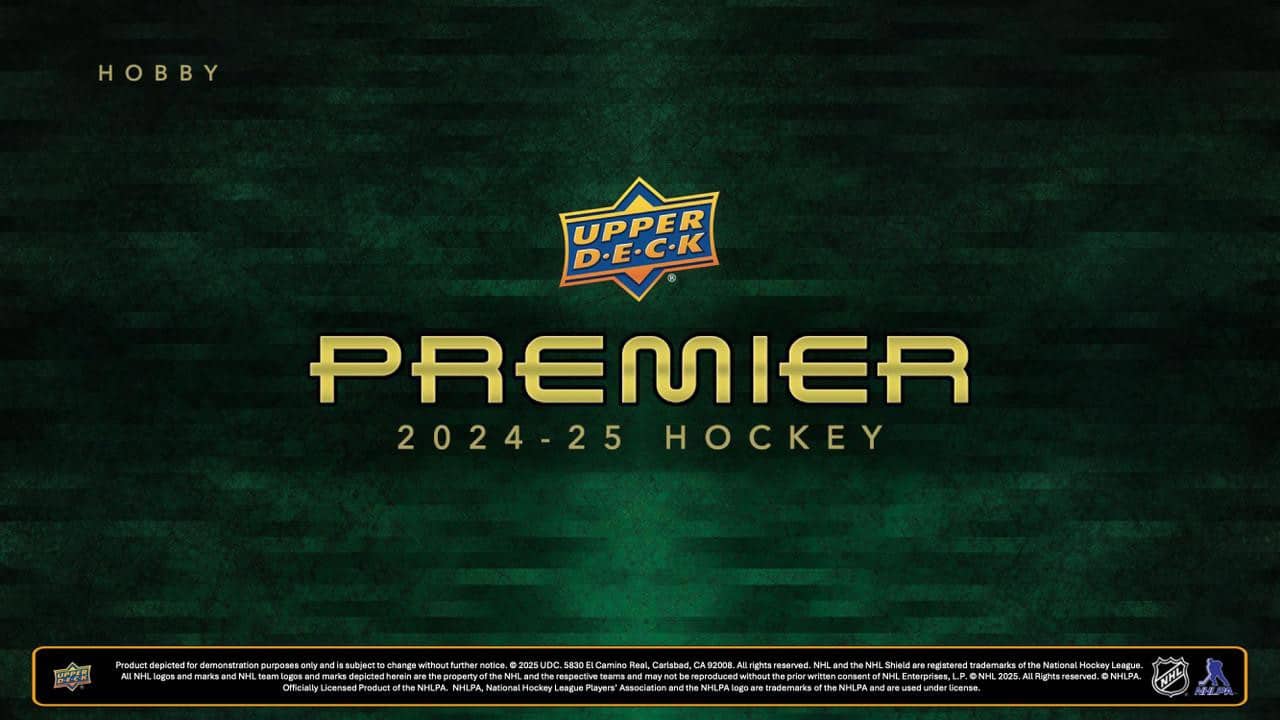

Look ‘n See mimics the collectability of sports cards. The early 1950s Topps Gum issue contains superstars, stars, and common cards like baseball releases. More importantly, 1952 Topps Look ‘n See is a feast for hobbyists chasing scarce, under-printed card numbers.
And yet, Look ‘n See is an enigma. For decades, researchers pondered the set’s configuration. Hobby scribes resort to supposition and educated guesses.
But in terms of ease of attainment, Look ‘n See is a reasonably straightforward chase compared to other ’50s non-sport issues. Moreover, the surviving population of these cards –at trade shows, in magazine advertising, and online auctions – is surprisingly robust.
As in many cases, the rub is the condition of the surviving cards.
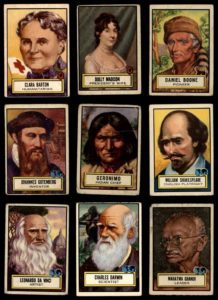
The 1952 Topps Look ‘n See is relatively easy to find (look for complete sets on eBay)
Sometime in the autumn of 1952, after Topps’ wrapped up its 1952 Baseball run, Look ‘n See began its extended, multi-year run. It appeared on candy store shelves and novelty shops throughout the Northeast and beyond.
The first 75 cards comprise Series One. Sixty cards make up Series Two.
The Series One components divide into eight subsets:
Card #s Subset
1-9 Presidents
10-31 Famous Americans
32-42 Military Leaders
43-46 Famous Women
47-52 Explorers
53-63 Men of the West
64-68 World Figures
69-75 Inventors
The 60-card Series Two configuration is, to put it mildly, a haphazard affair in terms of subset order. However, the numbering system (card 76, Pasteur, 77, Penn, et al.) remains a baseline. The subsets are spread across the balance of Series Two. Topps likely created this jumble of illogic to keep its young clientele guessing and purchasing packs.
Look ‘n See added two subsets — Famous Canadiens (numbers 99 and 100) and Famous Writers — to its Series Two mix, while Explorers disappeared in the fog.
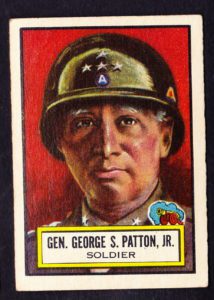
Military figures like General Patton are a cornerstone of the set (look for his cards on eBay)
Are there any athletes in the series? Just one. Babe Ruth (#15) emerges under the Famous Americans sub-issue. The firm previously used Bambino’s image in its 1951 Connie Mack All-Stars supplementary baseball issue and the 1948 Magic Photos multi-series collection.
At the time of Look’ n See’s publication, 16 of its subjects had been living contemporaries:
The lone survivor as of this writing is #104. God save the Queen.
Recollections from contemporary consumers provide invaluable testimony of any sets released in the early 1950s. Collector Eddie Grove penned a story for The Wrapper magazine (issue #84, July 1989) that offered latter-day insights into Look’ n See’s appearances in neighborhood candy shops.
“I remember (at) the store seeing all those packs in the box with all those question marks on the wrappers with the words’ magic and hidden pictures,'” Grove wrote. “Those things made us scoop up all the cards we could.”
Grove added he and his friends would cash in soda bottles for nickels to buy Look’ n See packs to “see the backs of those unknown answers” with the supplied red cellophane paper.
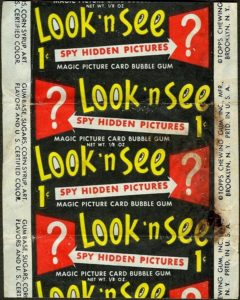
The packing of the cards inspired curiosity.
The challenge Topps Chewing Gum faced at the time was to set itself apart from its chief rival, J. Warren Bowman’s eponymous Philadelphia-based company. So Topps provided kids with proactive reasons or gimmicks to enhance schoolyard cache to win over Topps young customers.
In some cases, children would rub moisture into a card to reveal “magic pictures” (Magic Photos, 1948).s In some instances, young collectors split a two-card panel into a pair of single cards (Hopalong Cassidy, in 1950) and used red cellophane to read hidden messages.
It had all been a successful reworking of sales ploys enacted by children’s radio show sponsors of the 1930s and ’40s. Those shows often hawked clandestine decoder rings, special hidden message translators, and other interactive gadgets to further the program’s on-air popularity.
Topps’ Shorin brothers were shrewd marketers who recalled the publicity strategies of the Great Depression years. By 1952, their growing distribution network had been poised to knock Bowman off its pedestal. Among these Freedom’s War, Fighting Marines and Animals of the Zoo World (to name a few) formed responses to counter the Bowman card brand.
In the 1950s and the early ’60s, Topps distributed products in one-cent and five-cent pack varieties. We are still unsure if they used single-prints or multi-printed cards for Look’ n See‘s Series One. Some experts believe a 121-card press sheet containing single-, double- and triple-prints was used in the early 1950s sets, including that one.
What of Series Two? Debate, theoretical constructs, and general guesses are the rule. The key card historically has been (#82) Rembrandt. As any chaser of Look’ n See would testify, the Rembrandt is challenging to find in decent condition. Centering is the most common problem.
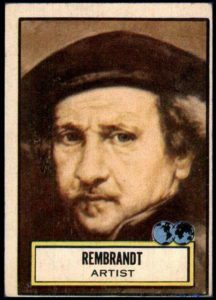
The Rembrandt card may be the key to understanding the printing method and run.
How is this relevant? David Hornish, the webmaster of The Topps Archives, has speculated on possible layouts of Look’ n See‘s second series card sheets. With anecdotal evidence to back it up, Hornish believes that Rembrandt had been a single-print card at the lower right-hand corner of the press sheet.
That would explain why the Rembrandt population of well-centered, well-conditioned pasteboard has always been low. The most common centering problem is the image sitting down toward the bottom and to the right, with miscuts a common sight.
It is, however, possible to find a near-perfectly centered Rembrandt. For example, in November 2021, Heritage Auctions offered and sold a PSA graded NM-Mt 8 specimen for $1,920. Additionally, in spring 2021, the same house sold a PSA NM-MT 8 Babe Ruth for $2,340.
In an undated interview, Hornish explained his latest theory:
“My take is that Look’ n See was printed in two series on an 11 x 11 half sheet array.” Hornish opined. “I think to Look ‘n See was the first set issued in the rough size that defined Topps from 1950 until very early 1952 that wasn’t intended to be issued in two-card panels . . . as Topps reconfigured the latter into Trading Card Guild cellos (a Topps marketing initiative) and transitioned the former from long horizontal packs to a more vertical look.”
In the magazine business, an “evergreen” story can be plugged into an issue at any time. Look’ n See is the card equivalent, a product ripe for any lull.
East Coast collectors who were children of the early 1950s remember the black and red boxes in the autumn and winter of 1952-3. The cards’ appearances continued well into the new year. Reportedly, Look’ n See was still vying for shelf space as late as 1956.
That would explain the considerable population of the title concerning contemporary non-sport set compilations. Its success was part of the successful bid to overtake Bowman alongside an expanded 407-card baseball release in 1953.
Since the organized trading card hobby began coalescing in the mid-1970s, Look ‘n See singles and lots have been relatively prevalent at trade shows. Baseball card vendors often offered them.
Reasons for the survival of so many cards are plentiful. First, apart from the educational aspect, Look ‘n See is a personality-driven set that youngsters could swap easily. A second, and perhaps ignored factor, is that both boys and girls could enjoy the title even in those more gender-constrictive times.
All Look ‘n See cards aren’t created equal, no matter what Thomas Jefferson (#3) would have thought. Some card subjects carry premium value regardless of their suspected single- or multi-print status. Organically, a Charles Lindbergh (#30) is more sought after than, say, Machiavelli (#106), despite the latter’s penchant for scheming.
Below are figures from a quick scan of recently completed eBay auctions and BINs from different sellers.
| #31 Ford (PSA EX-MT 6) | $39.99 |
| #70 Morse (PSA NM-MT 8) | $59.85 |
| #105 DaVinci (PSA EX-MT 6) | $45.97 |
| # 6 T. Roosevelt (PSA 8) | $149.85 |
| #3 Jefferson (VG) | $12.00 |
| #5 Truman (VG) | $5.00 |
| #8 Washington (VG-EX) | $12.00 |
| #15 Ruth (VG-EX) | $450.00 |
| #105 Elizabeth II (VG-EX) | $100.00 |
The important card number 1, President Franklin Roosevelt, carries an evident premium. A ballpark starting figure of $25 seems reasonable for raw VG cardboard. However, the FDR is prone to centering issues. As a result graded cards with no qualifications should result in three-figure asking prices.
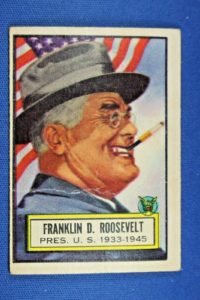
It is hard to find an FDR in good condition, but it is a beautiful card (look for them on eBay)
Eight Rembrandts were observed in current auctions and BINs. Asking prices ranged from $185 (raw, fair-poor) to $300 (raw, VG). Seven of the eight were off-centered to the right.
Considering Look’ n See‘s year of publication, raw common cards of either the first or second series remain relative bargains. However, collectors who don’t aim high for near-mint examples may build starters sets for a few dollars.
Nonetheless, a complete set cannot be obtained that cheaply. According to recent eBay listings, a whole Look’ n See set falls in a range of $1,500 for a Good condition run, $2,500 in mid-grade, and nearly $4,500 in Excellent. None of the above contained graded, slabbed cards.
If you prefer singles, here is what you need to know. Since the 1980s, the rule of thumb for Look’ n See‘s more sought-after Series One numbers has been comprised of Presidents (Washington, Lincoln); Famous Americans (Lindbergh); and Military figures (Eisenhower, Patton). Although important figures abound in Series Two, the key card remains Rembrandt.
Topps reused some of Look’ n See‘s art in later sets. For example, the depiction of a roaring Leif Ericson found its way onto the reverse side of the 1954 Scoop series (#149). Perhaps the most notable case relates to Babe Ruth. His Look’ n See portrait not only found its way into Scoop (#41) but also in disguise with the 1967 Who Am I? release (#12). Recycling artwork is as old as the hobby.
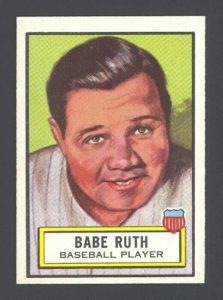
Topps liked the art on the Babe Ruth so much that they reused it (look for more Babe Ruth cards on eBay)
Autumn 2022 will mark the 70th anniversary of Look’ n See‘s release. We have no doubt it will maintain its proven appeal. The extant population of these cards, the intensity of interest among its initial young collectors, and, lastly, the existence of perceived scarce (Rembrandt) and cross-over (Ruth) pasteboards will undoubtedly remain drivers of this issue’s popularity.
How many other card titles –sports or non-sport –offer the same characteristics? The set draws qualities from both trading card genres. In the final analysis, Look ‘n See, including its high-end value cards, remains an affordable collectible title for its age.
Ripping the new Topps All Star Game mega box.
Is this new sports card store the BEST VALUE around?
I Tested eBay Auction Promotions So You Don’t Have To!
I deep-dove on Fanatics Collect so you don't have to (but should you?)
Panini is launching a WNBA Product at $30,000!?
Topps Chrome 2024-25 Basketball: Honest Review and Notes
Did you know this SECRET about PSA slabs? #sportscard #tcg
5 EASY tips to make more money on eBay sports cards.
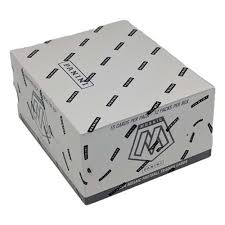
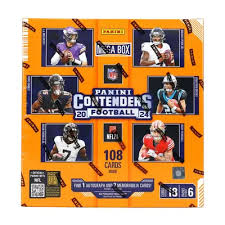
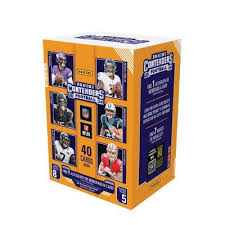
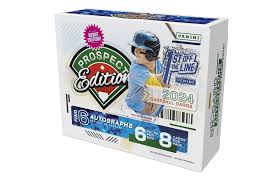
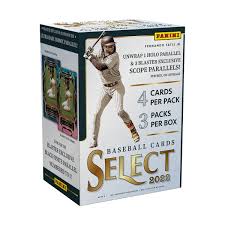
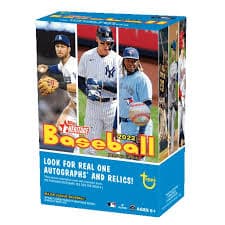
2022 Topps Heritage Baseball Blaster Box Configuration: 7 Packs per Box – 9 Cards per Box. Plus 1 extra pack.
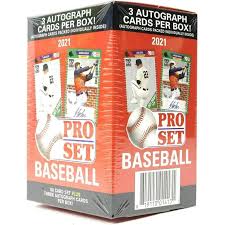
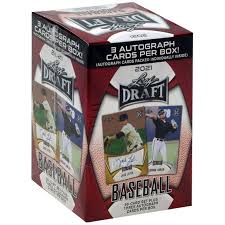
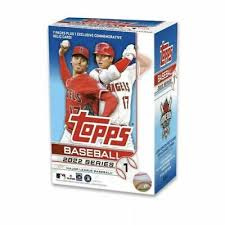
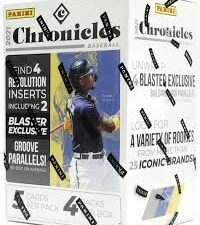
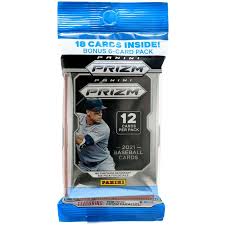
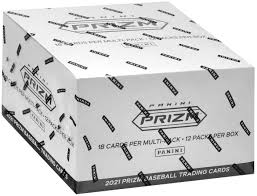

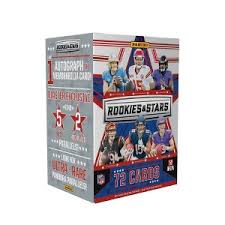
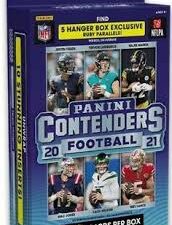
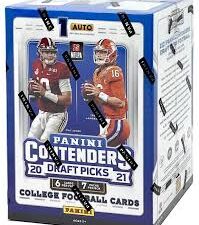
Keep up on breaking Sports Card News, our latest articles, product specials and exclusive content with expert analysis of hobby trends.

© Copyright 2025 - All rights reserved Cardlines.com / Media Techs LLC - Sports Card News, Reviews, Releases and BREAKS - #thehobby.
Important: When you click on links to various merchants on this site and make a purchase, this can result in this site earning a commission. Affiliate programs and affiliations include, but are not limited to, the eBay Partner Network.
2025 Topps All Star Game Mega Box Product Review
Cardlines 22 hours ago